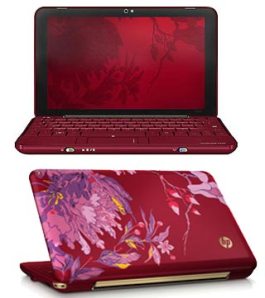
Yup! The title says it. I am My mum is now the proud owner of a HP Mini 210 Vivienne Tam, thanks to the kind folks at HP and Waggener Edstrom. I’ve been looking at Netbooks for quite a bit but never gotten down to owning one as I find them underpowered and undersized for my common activities (e.g: design and coding). Nevertheless, I put it in the hands of my shopaholic mum to see how the laptop fairs among its target group of users.
Windows 7 on a Netbook
When my mum first started the laptop, it loaded the Windows 7 OS immediately (instead of Splashtop HP Quickweb) so she ended up being disappointed with the speed of startup. It really did take quite a while (3 minutes) and the system response was slow even for simple activities like browsing the Internet. I think Win 7 is really too heavy duty to run smoothly on a netbook, especially if you’re used to the speed your conventional laptop and desktops have been providing.
Splashtop OS

The simple, Splashtop interface with a background that complements the exterior design
On the 2nd bootup, the HP Mini 210 launched the Splashtop HP Quickweb first. For those who are unfamiliar with this, Splashtop is like a mini lightweight OS that can perform the basic activities of a laptop. The activities you can perform are:
1) Surf the web
2) Instant Messaging (pretty nifty messenger that can support multiple chat accounts from multiple platforms)
3) Skype
4) Calendar
5) Media player (pictures, videos and music)
6) Email
From Splashtop, you can choose to launch Windows 7 if you wish to do other more heavy duty activities. Honestly, the Splashtop OS is really good. It covers all the basic activities you’d want to do with the netbook, and does it really well. Booting up only takes at most 10 seconds (yea!!) and it runs very smoothly. My mum was having such a pleasant experience with the OS that she has not seen the need to launch Windows 7 thus far.
Web Cam
Interestingly, Splashtop comes with a “Mirror” feature which lets you see yourself on the laptop. I guess they built this in for girls who want to ensure their appearance is tip top at all times. We checked the quality by video conferencing with my dad and based on his feedback, the webcam is sharp and has quite good coloring, albeit a bit laggy when there’s motion at times.
Splashtop Browser
I’m not sure if this is an issue with the netbook’s specs of the Splashtop browser.. but sites with AJAX loading (like the non-HTML version of Gmail) causes lags and random jumps when scrolling. Also, while I was typing an e-mail reply on Gmail, the text cursor kept jumping back to random positions in earlier parts of the page. In the HTML version of Gmail however this does not happen. I recommend all users to use the HTML version of any mail client they have to avoid this from happening, else you’d be pulling your hair out from typing those e-mail replies.
Design & Weight

Butterfly design on the cover
Very light. Mum has been carrying it in her handbag for a couple of days when visiting relatives and does not find any discomfort in carrying it around. Also, it is an attention grabber wherever we go, be it in a restaurant, friend’s house or cafe. Lots of people use netbooks at cafes nowadays but they still turn to stare when mum whips out the HP Mini 210 Vivienne Tam. Guess designer products really do have a different touch of class to them. 🙂
Overall
Looking at my mum’s experience with the digital clutch, the HP Mini 210 Vivienne Tam definitely does its owners proud in terms of both usability and design. Although underpowered for my tastes, it is adequate for people who are always on the move and looking for a product to perform basic functions like e-mail, web surfing and Skype whenever they’re sipping a cup of coffee. If you’re the above and a fashionista chic, consider getting the HP Mini 210 Vivienne Tam. You’d enjoy all the attention and class it gives onlookers 🙂

























Recent Comments